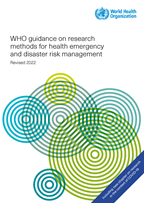- Home/
- Our Work/
- Health Emergencies/
- Research Methods/
- Sections and chapters/
- Section 4: Study design/
- Chapter 4.5 Advanced statistical techniques
Section 4: Study design
Chapter 4.5 Advanced statistical techniques

Research Methods for Health EDRM
Section navigation
- Section 4: Study design
- Chapter 4.5 Advanced statistical techniques
- Chapter 4.1 Basic principles in designing studies to assess the effects of interventions
- Chapter 4.2 Measuring the problem: Basic statistics
- Chapter 4.3 Cluster randomized trials
- Chapter 4.4 Collection and management of good quality data
- Chapter 4.6 Health-related risk modelling
- Chapter 4.7 Evaluating economic impacts in health emergency and disaster risk management
- Chapter 4.8 Geographic information systems
- Chapter 4.9 Real-time syndromic surveillance
- Chapter 4.10 Using logic models in research and evaluation of Health EDRM interventions
- Chapter 4.11 Researching communication and communicating research in Health EDRM
- Chapter 4.12 Qualitative research
- Chapter 4.13 Addressing complexity through mixed methods
- Chapter 4.14 Natural experiments in a hazard context
- Chapter 4.15 Monitoring and evaluation
Authors: Vigneri M, White H.
Chapter 4.5 describes the following more advanced factors in developing an impact evaluation for health emergency and disaster risk management (Health EDRM):
- Different approaches to estimating impact in the absence of random assignment.
- Advantages and disadvantages of these different approaches.
- Importance of baseline data for both intervention and comparison groups.
What is this chapter about?
Although randomized trials usually provide the most robust research method for comparing the effects of interventions, actions and strategies, these are not always possible in settings related to Health EDRM. When randomization is not possible, the relative effects of different interventions can be estimated through a range of other techniques and analyses, including quasi-experimental methods and regression-based approaches.
This chapter introduces some of the non-experimental quantitative methods that are available for impact evaluation studies in Health EDRM. These include propensity score matching, regression discontinuity designs and interrupted time series, and a regression-based approach called instrumental variable estimation. The strengths and limitations of these approaches are illustrated using case studies from disasters and other health emergencies.
Case studies presented in the chapter:
- Using propensity score matching (PSM) to measure the impact of humanitarian aid on the food security of rural populations in Mali.
- Using regression discontinuity designs (RDD) to measure the impact of a winter cash assistance programme to Syrians refugees in Lebanon.
- Using instrumental variables to measure the political effects of environmental change to understand the disaster–violence nexus in Sri Lanka.
What are the key messages of this chapter?
- Impact estimates are possible in the absence of randomization but require data from a comparison group that did not receive the intervention.
- The available methods may be subject to selection bias.
- It is important to test for baseline balance to check if any bias based on observables has been removed.
- The reliability of matching and the ability to calculate a double difference estimate are enhanced by the availability of baseline date for both the intervention and comparison groups.
